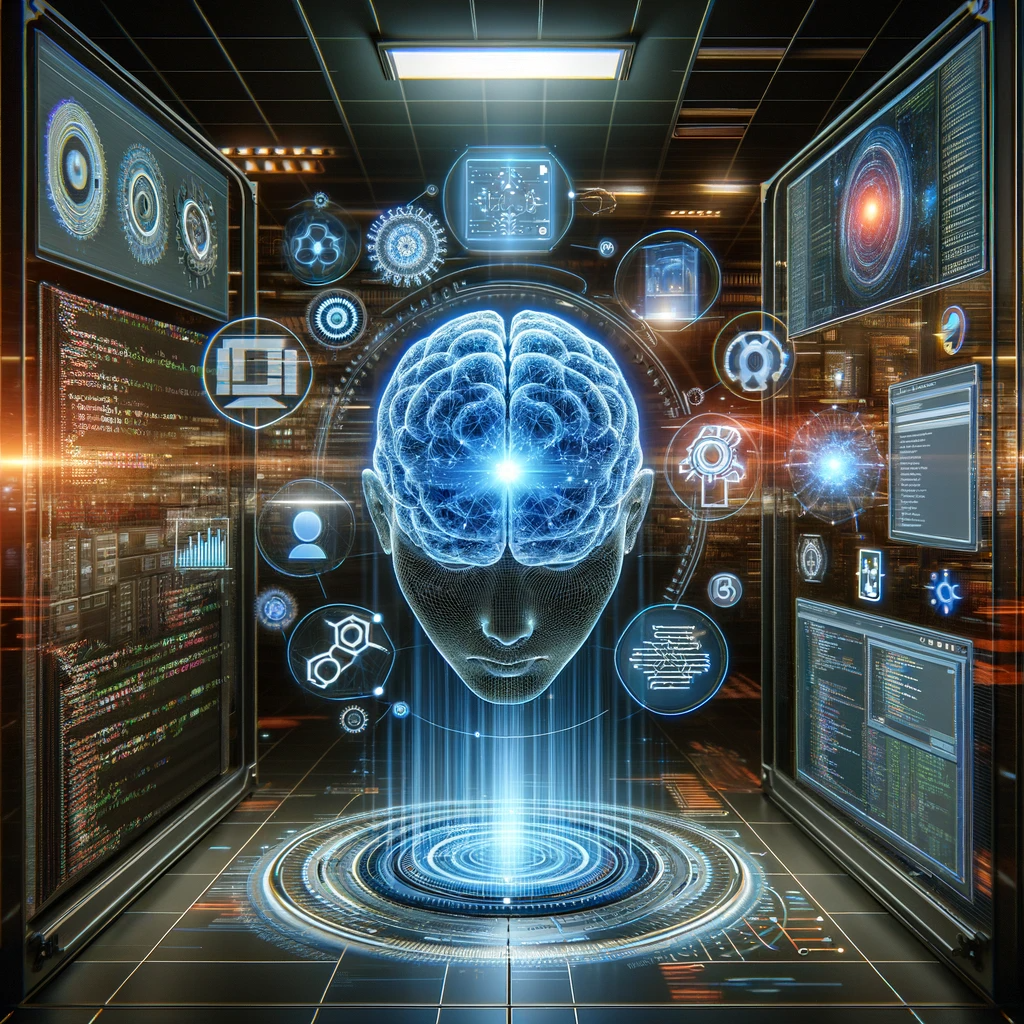How can AI enhance software development, you ask?
Well, let’s face it…
The world of software development is a complex maze.
Navigating through this labyrinth without the right tools or support can feel like trying to find your way out of an endless jungle in pitch darkness. But here’s where AI comes into play.
Talk about a game-changer!
I recently had a chat with a seasoned developer who told me that incorporating AI into his workflow transformed not only how he developed software but also the quality and efficiency of his output.
This made him wonder why he hadn’t embraced this tech marvel sooner!
Sounds incredible, doesn’t it?
But truth be told…
Table of Contents:
- AI in Requirements Elicitation
- Enhancing Requirements Analysis with Artificial Intelligence
- Role of AI in Requirements Documentation
- The Impact of Artificial Intelligence on Task Management
- Integrating Artificial Intelligence Into Requirement Engineering (RE)
- Conclusion
AI in Requirements Elicitation
In software development, requirements elicitation is a crucial first step. It’s about gathering information from stakeholders to comprehend their needs and expectations. Techniques such as interviews, surveys, workshops, and observation – all play an important role here. Now imagine enhancing this process with artificial intelligence (AI). That’s right. AI has the potential to streamline these tasks, making them more efficient.
Automating Elicitation Techniques with AI
The traditional way of doing things often involves manual labor, which can be time-consuming, especially when conducting interviews or surveys for requirement gathering. Planning and executing these activities require significant human effort, not forgetting data analysis post-execution.
This is where Artificial Intelligence provides automation solutions that were once considered labor-intensive tasks. Watson Assistant, one among many AI tools by IBM uses natural language processing (NLP) technology capable of automating interview-based elicitation methods through conversational interactions with users thus collecting required data seamlessly.
Surveys, too, have seen transformation under machine learning algorithms’ influence in analyzing response patterns and trends automatically without any need for manual intervention at all.
Improving Feedback Mechanisms through AI
Apart from just automation, though, there lies another area where Artificial Intelligence truly shines – feedback provision during the requirement elicitation phase itself based on insights gathered from collected data.
Beyond conflict identification, advanced neural networks facilitate enhanced feedback mechanisms, allowing developers to make informed decisions regarding feature prioritization along design choices, leading towards better user experience, ultimately benefiting end-users themselves alongside those involved directly within the software development industry.
Enhancing Requirements Analysis with Artificial Intelligence
The world of software development is no stranger to the complexities and nuances that come along with requirements analysis. It’s a crucial part of any project, involving refining, organizing, prioritizing, and modeling elicited needs from stakeholders. But here’s where artificial intelligence (AI) steps in – it can make this process not just manageable but also more efficient.
Automation of Activities using AI
If you’ve ever found yourself lost amidst manual tasks like data collection or organization during your software development processes, then AI might be exactly what you need. By automating these activities through machine learning algorithms and other advanced technologies within the realm of computer science, developers are freed up to focus on strategic decision-making aspects rather than mundane repetitive tasks.
In addition to automation capabilities provided by such AI tools, there’s an additional layer brought into play: natural language processing (NLP). This technology allows for textual requirement documents to be understood semantically, which means extracting meaningful insights directly without needing extensive preprocessing steps typically required by traditional methods.
Augmenting Human Capabilities with Advanced Tools
Apart from making life easier via task automation, another key advantage offered by artificial intelligence lies in augmenting human abilities through advanced analytical tools. These sophisticated solutions provide visualization features allowing users to easily interpret complex datasets, thereby enabling them to make informed decisions based on those interpretations. The result? Reduced errors due to misinterpretation and misunderstanding during the requirements analysis phase, leading to improved overall quality assurance within projects while minimizing potential rework costs later down the line when issues are discovered post-deployment stage.
- Data Science methodologies coupled with deep learning technologies offer further enhancement opportunities for predictive analytics models capable of predicting future trends and outcomes based on historical information available – an invaluable asset for planning resources and scheduling timelines around product releases and updates.
- This foresight enables a proactive approach to management, minimizing risks associated with unforeseen changes and developments, enhancing overall project success rates in the long run. Note: Augmentation doesn’t replace humans; instead, it amplifies their skills and makes work more effective and productive, especially in areas requiring high-level cognitive functions, creativity, problem-solving, critical thinking, etc., thus creating a symbiotic relationship between man and machine that truly revolutionizes the way we conduct business today.
Role of AI in Requirements Documentation
The application of artificial intelligence (AI) within the software development industry is revolutionizing how developers manage requirements documentation. This traditionally labor-intensive task can be significantly streamlined with the use of AI-powered tools.
Simplifying Documentation Formats through Automation
Artificial Intelligence has a critical role to play when it comes to automating various facets involved in requirements documentation. For instance, text documents are often simplified by automatically generating summaries or highlighting key points using natural language processing techniques – an aspect that helps condense information for easy comprehension and quick referencing.
Beyond just textual content, diagrams form another crucial component used during this phase. Developers frequently employ flowcharts or UML diagrams as visual aids representing system behavior and interactions. Here again, artificial intelligence proves its worth by auto-generating these complex visuals from simple textual descriptions – saving substantial amounts of time while ensuring accuracy.
Augmenting Human Abilities for Effective Use Cases
Moving beyond mere automation lies augmentation where AI enhances human capabilities rather than completely replacing them. One area where this concept shines brightly is creating effective use cases and user stories – vital parts of any requirement document that outline specific scenarios or actions a user might undertake within the system.
In such instances,AI algorithms, including machine learning algorithms along with deep learning models come into play: They analyze historical data on past projects predicting potential challenges related to different features being developed guiding developers towards crafting more comprehensive use cases covering not only expected usage patterns but also edge conditions they may have overlooked otherwise.
Note:
Despite their power A.I tools aren’t perfect hence always wise manually verify results ensure no critical change missed.
Hence we see Artificial Intelligence isn’t merely disrupting traditional methods, it’s transforming way we approach tasks making us efficient effective every step way.
The Impact of Artificial Intelligence on Task Management
Artificial intelligence is revolutionizing task management within the realm of requirement engineering. It’s not just about automating mundane tasks anymore, AI systems are now equipped to offer sophisticated decision-support mechanisms.
Smaller software dev firms don’t have to be left behind when it comes to taking advantage of the advances in automation within the industry. Even smaller software development companies can leverage these advancements for improved efficiency and accuracy.
Detecting Changes Using Automated Systems
Change detection plays a pivotal role in requirements management. Traditional methods often required constant vigilance from project managers or developers, which was both time-consuming and prone to human error.
Managing Configurations Efficiently With Help from A.I.
In complex projects involving multiple teams with interdependencies, configuration management has always been challenging using traditional methodologies that relied heavily on documentation tracking spreadsheets – all susceptible to human errors and oversights.
Leveraging artificial intelligence for this purpose introduces new levels of precision and speed to the entire process; version control becomes a breeze thanks to advanced features offered by many modern platforms today, while predictive analytics provide insights into potential bottlenecks and areas needing attention based on historical data patterns, thus helping avoid costly delays down the line by identifying problems before they become critical roadblocks in your workflow.
Aiding Decision Making Through Intelligent Recommendations
Making decisions during any phase in software development could prove daunting due to several factors involved – timelines, costs associated with each option available, etcetera. But when you leverage AI technologies, deep learning neural networks coupled with natural language processing abilities inherent in certain intelligent systems, making informed decisions becomes easier than ever before. Say there arises a need to modify a specific feature mid-project; instead of manually analyzing the impact of said modification on the overall outcome, considering aspects like budget implications and schedule disruptions, simply feed the information regarding the proposed change to the system and let it do the heavy lifting on your behalf. Based on the vast amount of past data stored in its database, along with the current input provided, the system is able to generate a comprehensive report detailing possible outcomes of the ensuing action, enabling you to make a well-informed decision.
Integrating Artificial Intelligence Into Requirement Engineering (RE)
The software development industry is witnessing a revolutionary shift with the integration of artificial intelligence into requirement engineering. This fusion not only streamlines various tasks but also augments human capabilities, driving efficiency in all activities related to requirements management.
In essence, AI-powered tools reduce manual effort while minimizing errors typically associated with traditional methods. They allow coders to concentrate more on creating software rather than sifting through a huge amount of information.
Automation of Processes in RE via A.I.
The automation brought about by integrating AI technologies into requirement engineering offers several advantages. One significant benefit is that it allows for automatic extraction and analysis of user requirements from varied sources – emails, chat logs or even social media posts.
- Natural Language Processing: It helps understand complex language structures within these documents making it easier to extract meaningful information impacting the development process.
- Machine Learning Algorithms: These are used for automatically classifying and prioritizing requirements based on their relevance and importance for projects at hand.
Augmentation Methods Provided By A.I For Optimized RM
Beyond mere task automation lies another significant aspect offered by integrating artificial intelligence – augmentation. Herein lies potential for AI systems working alongside humans enhancing abilities while simultaneously improving productivity levels within software development companies.
- Leveraging Deep Learning Models: During code review phases they help identify bugs or security vulnerabilities before deployment; saving valuable time ensuring high-quality output. Towards Data Science.
Apart from this an equally important area where augmentation comes into play involves decision-making support provided by intelligent agents which assist teams make decisions based upon historical data patterns thus reducing risk factors associated poor judgement calls during critical stages product lifecycle.
Last but definitely not least role played does extend further towards mundane yet essential tasks such documentation generation wherein neural networks create detailed reports outlying work progress without requiring any direct input team members themselves freeing up precious resources allowing developers concentrate effectively core competencies instead.
Conclusion
AI in software engineering is no longer a mere fad, but rather an evolution.
From requirements elicitation to analysis, AI is automating and enhancing processes like never before.
Documentation has been simplified, human abilities augmented for effective use cases and user stories creation.
The impact on task management? Nothing short of transformative.
Detecting changes with automated systems or managing configurations – all made efficient by the power of AI.
Incorporating artificial intelligence into requirement engineering optimizes every aspect of Requirement Management (RM).
If you’re intrigued by how AI can enhance software development and other digital technology topics such as data science or large language models,





